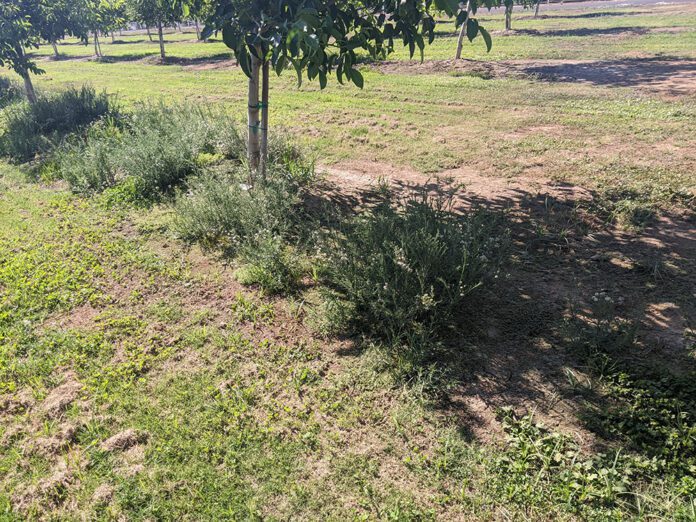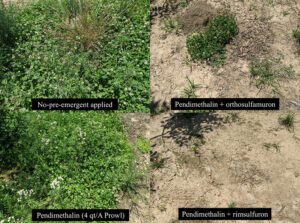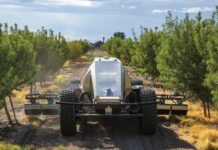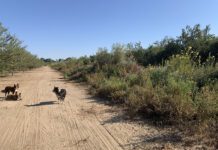
Listen to the audio version of this article. (Generated by A.I.)
Weed control in California walnut orchards has never been more challenging. Herbicide resistance is spreading, and deep-rooted perennials are becoming harder to manage each season. For walnut growers, keeping orchard floors clean now requires sharper timing, stronger rotations and closer attention to resistance patterns that can erode product effectiveness over time.
For Ryan Hill, UCCE farm advisor for Glenn, Tehama and Shasta counties, that challenge has become a defining focus. He has spent the last several seasons testing herbicide programs in the northern Sacramento Valley to help growers and PCAs identify combinations that balance effectiveness, resistance prevention and cost.
“Our nut orchards are generally pretty clean, but the herbicide rotations are sometimes not very robust,” Hill said.
After sharing that observation, Hill told PCAs and CCAs during the Crop Consultant Conference in September that while many orchards remain manageable today, relying on a few familiar products is a short-term solution that could create bigger problems ahead.
Regional Perspective
Hill covers the northern end of the Sacramento Valley, an area where higher rainfall, heavier soils and colder winters shift weed pressures compared to orchards farther south.
For winter preemergent treatments, he explained, he sees some growers using Alion year after year, sometimes in combination with Matrix, an acetolactate synthase (ALS) inhibitor with good postemergent activity, and not rotating much. For perennial weeds, he added, it is often Roundup in the summer. Those practices may seem effective for now, but Hill warned they are not sustainable.
“A common choice for our growers is to apply later in the season, after many winter annual weeds have already germinated,” he said. “Also, for those who do have that dialed in and are able to control those resistant weeds, I often see an inadequate rotation of herbicides.”
Repeated use of the same herbicide, even strong preemergent products or mixes, may seem effective in the short term but can increase the risk of resistance over time.
“These herbicides are some of the most regular offenders for herbicide resistance. If you spray the same product over and over, you are going to have a lot of trouble, so be careful.” – Ryan Hill, UCCE, on ALS inhibitors
Demonstration Trials
To give PCAs side-by-side comparisons, Hill set up a walnut herbicide demonstration trial with 20 preemergent treatments applied either in February or March. Treatments were scored on reduction in weed coverage relative to untreated controls, grouped into categories ranging from poor (less than 50%) to excellent (more than 90%).
The site provided a tough test, with glyphosate-resistant hairy fleabane present at application. “Alion has great preemergent activity on hairy fleabane, but I had poor control with this February application,” Hill said. “Control was about 40%, likely due to escapes coming through the postemergent cleanup spray [Roundup and Rely] included in every plot.”
He added that Alion provides little to no postemergent activity, so much of the observed benefit came from the added postemergent activity of other soil-residual herbicides. ALS-inhibiting herbicides like Matrix, Craze and Mission performed strongly on emerged fleabane in early winter, Hill noted, reflecting the similar mode of action they share.
“For resistance management, it is not really a good rotation between the three of them,” he explained. “But they do have different strengths and weaknesses, and they all have very good postemergent activity on hairy fleabane.”
He noted that Goal and Chateau also provided moderate control of emerged hairy fleabane, also likely due to greater postemergent activity.

Holding Through Summer
Residual weed control often declined by midsummer, even though one of the main goals of using preemergent herbicides in orchards is to maintain control through the summer months.
“Very few products are able to do that well,” Hill said. “You can get that activity if you have a sequential application, but in my trials, I was applying primarily in February, and only a few products were making it through July.”
Those included February-applied indaziflam (Alion), flumioxazin (Chateau) and pendimethalin (Prowl). He added that, of 20 treatments, just five carried through July, evidence that a single winter pass often is not enough when building a robust rotation for resistant species.
One surprise was an ALS inhibitor applied in March that held into July, underscoring the value of precise timing. Hill also noted that Brake On! (pending California registration) showed promise on summer-germinating broadleaf and grass weeds and could be a useful fit for resistance management (once available) due to its unique mode-of-action, provided labels allow.

Controlling Perennials
Beyond annual weeds, Hill’s work also looked at perennials, such as white clover, yellow nutsedge and Johnsongrass. With residual products, “you are not just relying on a systemic postemergent like glyphosate to control your perennial weeds,” he said.
In some cases, rimsulfuron (Matrix, Revolt, Hinge, and others) provided suppression or control of established perennial weeds. Hill noted that while preemergent herbicides typically bind tightly with organic material, results from a grower project in Shasta County were encouraging.
“I think it is safe to say there is soil residual activity on established Johnsongrass rhizomes,” he said.
Still, Hill said rimsulfuron proved inconsistent as an in-season option for johnsongrass control, with glyphosate products and grass-selective herbicides offering more reliable control.
Rimsulfuron was more effective in spring applications as weeds were emerging through the soil.
ALS inhibitors also performed well on other perennial weeds, with rimsulfuron and flazasulfuron (Mission) handling white clover well and orthosulfamuron (Craze) providing good residual control of yellow nutsedge. Sulfentrazone (Zeus; PPO inhibitor) also provided excellent residual yellow nutsedge control.
Resistance Concerns
While ALS inhibitors stood out in his trials, Hill warned of their risks.
“These herbicides are some of the most regular offenders for herbicide resistance,” he said. “If you spray the same product over and over, you are going to have a lot of trouble, so be careful.”
Tank mixes provided more reliable results, and ALS inhibitors combined with longer-lasting residuals like Prowl delivered some of the cleanest orchards through summer.
Applying Results Locally
Hill stressed that his trial results should be used to guide decisions, rather than as prescriptions. Conducted primarily in Tehama County, his trials reflect higher rainfall, heavier soils and colder winters than many other growing regions. Weed growth and phenology differ, and because the work was done in walnuts, some products may not be labeled for use in other crops.
“That is the PCA’s job, to take data elsewhere and apply it to specific circumstances and do the best with what you know,” Hill said.
The key principles that emerged across trials were timing, rotation and residual activity, all of which play a critical role in orchard weed control. Orchards sprayed with preemergent herbicides soon after harvest tend to stay cleaner than those treated later in winter, when many annual weeds have already germinated. Delaying applications almost guarantees escapes, particularly among glyphosate-resistant species.

Kristin Platts | Digital Content Editor and Social Correspondence
Kristin Platts is a multimedia journalist and digital content writer with a B.A. in Creative Media from California State University, Stanislaus. She produces stories on California agriculture through video, podcasts, and digital articles, and provides in-depth reporting on tree nuts, pest management, and crop production for West Coast Nut magazine. Based in Modesto, California, Kristin is passionate about sharing field-driven insights and connecting growers with trusted information.















